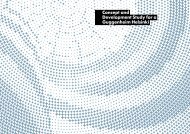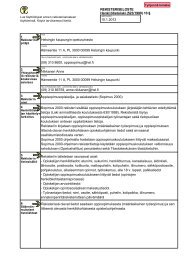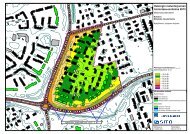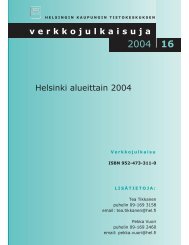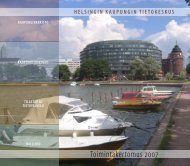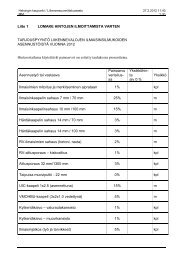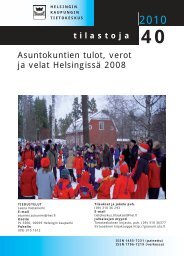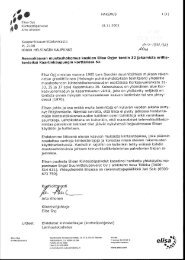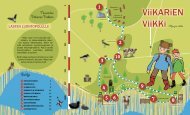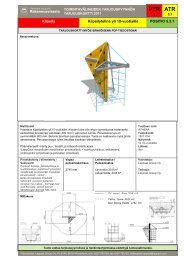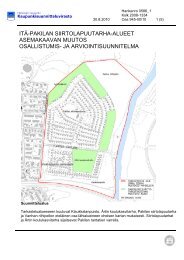Julkaisu - Hel2
Julkaisu - Hel2
Julkaisu - Hel2
Create successful ePaper yourself
Turn your PDF publications into a flip-book with our unique Google optimized e-Paper software.
Summary: Preliminary survey on the<br />
development of urban structures<br />
HARRY SCHULMAN, HELSINKI UNIVERSITY, DEPARTMENT OF GEOGRAPHY<br />
In the development of major cities, changes occur<br />
that can be seen in many ways in the physical environment<br />
of the cities, in their functional structure and<br />
their social interaction. In discussions, changes are<br />
often linked to globalisation and the tightening international<br />
business competition, and to abilities to control<br />
urban sprawl and social differentiation.<br />
In Finland, too, factors triggering change in regional<br />
structures and urban development are seen to<br />
have changed. The regional structure of the country<br />
has been characterised by an accumulation of population<br />
and functions in a few big urban regions. In<br />
these growth centres, development expresses itself<br />
as a concentration of habitation and functions in the<br />
city centres and as population growth in the zones<br />
around the urban core. Automobilisation, especially,<br />
has changed the structure of cities.<br />
Urban structures that have differing physical and<br />
functional properties can be identified and modelled<br />
as comprehensive systems and corresponding zones.<br />
In the development of post-industrial, “modern” cities,<br />
two very different main trends have been visible.<br />
Historical city centres and suburbs with good public<br />
transport have had an important position in most European<br />
big cities. Cities in North America and Australia<br />
have seen the birth of an automobile-adapted<br />
urban structure, where public transport plays a modest<br />
role. In all cities, you can find structures and milieus<br />
of a pedestrian city as well as a public transport<br />
and a car-borne city, but it seems that the structural<br />
features of a car-borne city and car dependence<br />
among households are getting stronger in Europe and<br />
Finland as well.<br />
To study these issues, a large consortium by the<br />
name of KARA has been formed with representatives<br />
of the Finnish Environment Institute SYKE, the cities<br />
of Helsinki, Espoo and Vantaa from the Helsinki<br />
Metropolitan Area, the core cities of the Turku, Tampere,<br />
Oulu and Kuopio regions, and several provincial<br />
authorities and regional environment centres.<br />
The objectives of the KARA Survey are (1) to<br />
clarify and unify the concepts and terminology relating<br />
to structural development in city regions, (2)<br />
produce measured and analysed research findings<br />
about the structural development of big city regions,<br />
(3) stimulate discussion and interaction between researchers,<br />
planners and administration and (4) back<br />
up the work being done on structural models and<br />
development pictures in big city regions. At a concrete<br />
level, the KARA Survey includes seminars and<br />
researcher meetings, case studies and relating exchange<br />
of findings, comparisons of city regions, and<br />
analyses of developments in Finland based on international<br />
research.<br />
Quantitative research on urban structures – development<br />
of indicators of structural properties and<br />
calibration and functionality-checking of gauges for<br />
these – provide a good opportunity to develop the<br />
YKR data system for the monitoring of community<br />
structures run by the Finnish Environment Institute<br />
SYKE.<br />
In a European comparison of major cities (EEA<br />
2006) the Helsinki Region is mentioned as a warning<br />
example of urban sprawl. Decades ago, the structure<br />
of the Helsinki Region became scattered. Recent developments,<br />
however, have been towards a more compact<br />
urban structure, as figures on population density,<br />
for example, show. And yet, sprawl in the region’s<br />
periphery is undoubtedly a problem. More detailed<br />
research into these phenomena is needed.<br />
58




